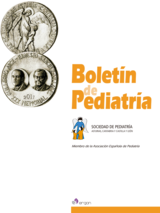Meningitis B en niño portador de derivación ventriculoperitoneal
J. Sánchez Arguiano , M.S. Holanda Peña , J.M. Lanza Gómez , T. Obeso González
Bol. Pediatr. 2017; 57 (239): 39 - 41
La meningitis bacteriana es una emergencia médica, y el diagnóstico debe ser inmediato. La tasa de mortalidad si no es correctamente tratada es cercana al 100%; incluso con un tratamiento óptimo, existen gran morbilidad y secuelas neurológicas. Los organismos responsables dependen de distintos factores de riesgo entre ellos los factores subyacentes del huésped; los más comunes en la población pediátrica son el neumococo y meningococo. La incidencia de esta patología ha disminuido en parte por las campañas de vacunación contra la mayor parte de estos microorganismos causales. Presentamos aquí un caso clínico complejo de un niño de dos años portador además de una derivación ventriculoperitoneal con meningitis por Neisseria meningitidis B; de especial interés, no solo por el microganismo causal, sino por el tiempo de terapia, más prolongado del habitual (2 semanas frente a 1) y la antibioterapia utilizada. Se propone la posibilidad de asociar antibióticos que prevengan y traten la formación de biopelículas en casos concretos, como la presencia de dispositivos tipo shunt; y la extensión del tiempo de terapia en determinados casos.
Meningitis B in child with ventriculoperitoneal shunt
Bacterial meningitis is a medical emergency, and the diagnosis should be immediate. The mortality rate, if it is not properly treated, is close to 100%. Even with optimal treatment, there is great morbidity and neurological sequelae. The responsible organisms depend on different risk factors, including the underlying factors of the host; The most common organisms in the pediatric population are pneumococcus and meningococcus. The incidence has been reduced due to the vaccination campaigns against these causal microorganisms.
We present here a complex clinical case of a two year old child with a ventriculoperitoneal shunt with meningitis caused by Neisseria meningitidis B; the special interest is not only for the causative microorganism, but for the time of therapy, longer than usual (2 weeks vs 1) and the antibiotic therapy used.
It is proposed the possibility of associating antibiotics that prevent and treat the formation of biofilms in specific cases such as the presence of shunt devices; and the length of therapy time in certain cases.
Artículo completo (PDF) (60 kb.)
